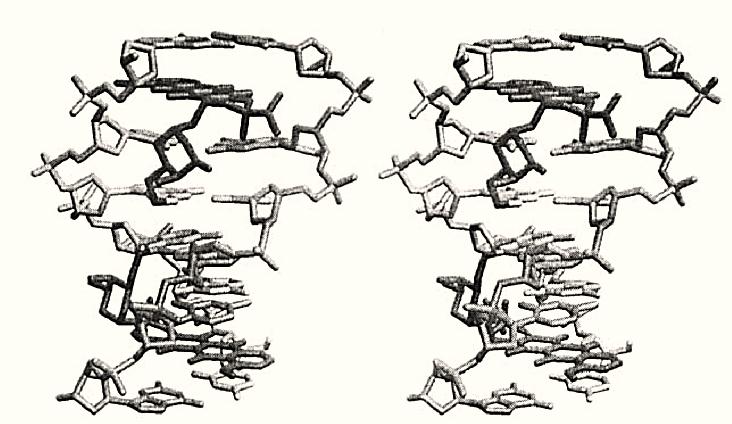


 النبات
النبات
 الحيوان
الحيوان
 الأحياء المجهرية
الأحياء المجهرية
 علم الأمراض
علم الأمراض
 التقانة الإحيائية
التقانة الإحيائية
 التقنية الحيوية المكروبية
التقنية الحيوية المكروبية
 التقنية الحياتية النانوية
التقنية الحياتية النانوية
 علم الأجنة
علم الأجنة
 الأحياء الجزيئي
الأحياء الجزيئي
 علم وظائف الأعضاء
علم وظائف الأعضاء
 الغدد
الغدد
 المضادات الحيوية
المضادات الحيوية|
Read More
Date: 1-11-2015
Date: 9-12-2020
Date: 9-6-2021
|
DNA Dynamics
DNA possesses many properties associated with a linear polymer, including various mechanical ) rigidity) and motional properties. The normal B-DNA is considerably more flexible than both A-DNA and Z-DNA. DNA structure in solution has two classes of motional properties: large-scale and local motions. The large scale tumbling motion of a DNA duplex of the size in the range of 10–100 base pairs has a correlation time of nanoseconds to microseconds. It is related to rigidity of the duplex (of varying composition and sequence) as measured by the persistence length. This global flexibility of DNA can be used to understand the behavior of DNA in solution and in gels. There are also local motions that are important in the biological functions of DNA. The dynamic properties of DNA allow it to stretch, bend, twist, and so on. The binding of many intercalators to DNA requires that adjacent DNA base pairs be separated to 6.8 Å in order to accommodate the aromatic intercalator. This is a large conformational change (including sugar pucker rearrangements), involving many torsion angles. Since the binding of intercalators is a reversible process, DNA must be in constant motions, so that the on-off binding process can happen at any time. Figure 1 shows the high resolution structure of the complex between the anticancer drug daunorubicin and CGCGCG crosslinked by formaldehyde (1). Finally, the motion of DNA or drug–DNA complexes may be analyzed by high resolution X-ray crystallography structure refinement that incorporates refinement of anisotropic temperature factors. This demonstrates that various parts of the complex have different motional properties, as is evident in their thermal ellipsoids.

Figure 1. The three-dimensional structure of the daunorubicin–CGCGCG complex (Protein Database DDF023).
Some dinucleotide steps, such as CpG, TpA, or TpG (= CpA), appear to be more flexible (see Base Pairs). In fact, those steps are the preferred binding sites for intercalator binding. They are also the preferred kinked sites induced by binding of proteins. The local dynamic property associated with the CpG site (and other sites) has been probed by high resolution and solid-state nuclear magnetic resonance (NMR) spectroscopy (2). The line shape analysis of the 2H-NMR spectra of the dodecamer CGCGAATTCGCG, with the 2H probe incorporated at different sites of the DNA, suggested that the deoxyribose of the C9 residue has a greater motional amplitude than do the other nucleotides. The atypical motional property of the CpG step has been attributed to be correlated with the cleavage at this site by the restriction enzyme EcoRI. Therefore, the local dynamics of DNA clearly play important roles in DNA bending induced by proteins, in binding of intercalators, in restriction enzyme action, and undoubtedly in other biological functions.
References
1. A. H.-J. Wang, Y.-G. Gao, Y.-C. Liaw, and Y.-K. Li (1991) Biochemistry 30, 3812–3815.
2. B. H. Robinson, C. Mailer, and G. Drobny (1997) Annu. Rev. Biophys. Biomol. Struct. 26, 629–638.



|
|
|
|
دراسة يابانية لتقليل مخاطر أمراض المواليد منخفضي الوزن
|
|
|
|
|
|
|
اكتشاف أكبر مرجان في العالم قبالة سواحل جزر سليمان
|
|
|
|
|
|
|
اتحاد كليات الطب الملكية البريطانية يشيد بالمستوى العلمي لطلبة جامعة العميد وبيئتها التعليمية
|
|
|